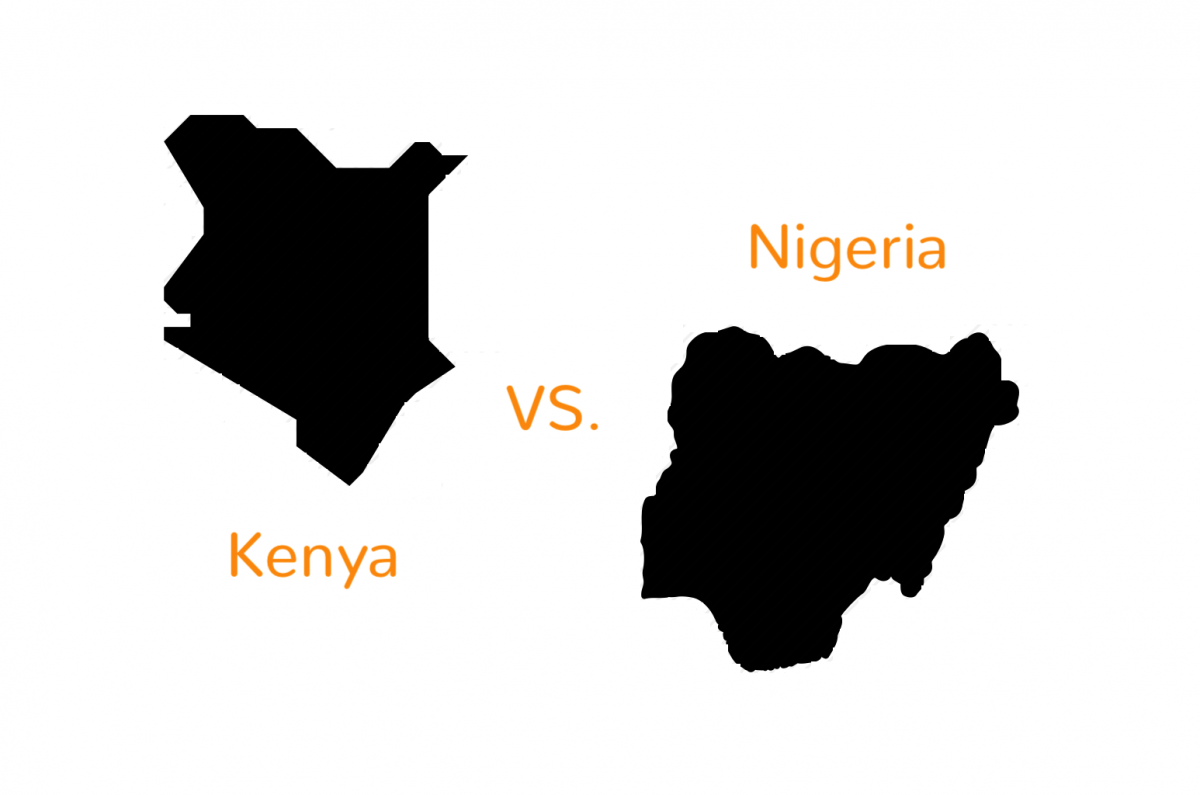Performing a quick country-by-country comparison between business in Kenya and business in Nigeria gives business managers a reference point on how to prioritize each market for their growth plans in 2019.
To support business development and sales managers in assessing which African country to prioritize in their organization’s expansion plan, we developed a tool (kpakpakpa’s Africa Market Potential Index- AMPI) that provides a quick way for managers asses market potential across the African continent.
Our Africa market potential index (AMPI) measures key metrics in critical areas of each country’s economy, social-political landscape, technological adoption, infrastructural developments, and the efficiency of doing business.
kpakpakpa’s AMPI measures the market attractiveness of 48 African countries, across seven pillars. These seven pillars act as key determinants to the short and long-term market potential of each country.
The seven pillars, and their respective weighting factor, that make our market potential Index
Factors
Description
Weighting
Market Size & Appeal
This evaluates the size and appeal of the domestic market.
20%
Macroeconomic Resilience
Measures the stability of the macroeconomic environment.
20%
Political Landscape & Governance
Measures the quality of governance.
10%
Social & Human Development
Measures social development of the country.
10%
Investment in Technology, Infrastructure & Logistics
Measures the efficiency of technology, logistics, and infrastructure as a supporting base for the business environment.
15%
Economic Diversification
Measures the degree of dependence of the economy on the sectors and resources in the country.
10%
Business Ease
Measures the ease of doing business in the country.
15%
Market Potential Index
The weighted average of the seven factors above to determine the market potential of each economy.
100%
Within each pillar, a set of key indicators have been included with specific weightings to arrive at the overall pillar rank and score. The first two pillars – market size & appeal and macroeconomic resilience – are short-term factors, and account for 40% of the total weighting.
The other five pillars are long-term factors and this account for the remaining 60% of the total weighting.
There are definitely no absolutes in the search for the best market to prioritize in Africa. There will be different answers for different organizations and industries.
You would know best what is necessary to asses opportunity and risk for your organization’s growth plans. Use this tools as a starting point to find the countries that fit properly with your company’s expansion strategy.
We use this tool to perform country comparisons.
Business in Kenya vs. Nigeria
In this article, we do a country-by-country comparison to understand the market potential of doing business in Kenya vs. Nigeria. The market potential across the seven pillars for both countries are:
Nigeria
Kenya
Market Size & Appeal
88
22
Macroeconomic Resilience
29
64
Political Landscape & Governance
58
67
Social & Human Development
52
74
Investment in Technology, Infrastructure & Logistics
36
57
Economic Diversification
6
32
Business Ease
55
76
Africa Market Potential Index (AMPI)
48
54
The market potential for business in Kenya is higher than that of Nigeria.
Out of all seven market pillars except for market size and appeal, Kenya performs better than Nigeria.
Country Information
Here is some basic information about both countries.
Nigeria
Kenya
Full Name
Federal Republic of Nigeria
Republic of Kenya
Flag
–
–
Currency
Nigerian Naira
Kenya shiling (KES)
Time Zone
(UTC + 1)
(UTC+3)
Capital city
Abuja FCT
Nairobi
Climate
Temperate
Warm and humid tropical to temperate along the coastline
Area
West Africa
East Africa
Telephone code
(+234)
(+254)
Market Size, Appeal & Resilience
The only pillar that business in Nigeria performs better that business in Kenya is Market size & appeal.
With a GDP over 4x that of Kenya, Nigeria’s market size and appeal for business expansion is more appealing than that of Kenya. However, Kenya boasts a more resilient macroeconomic landscape with lower inflation, interest rates, and unemployment levels.
Nigeria
Kenya
GDP ppp (nominal)
$1,325.81 Billion
$183.78 Billion
GDP (nominal)
$376.28 Billion
$74.94 Billion
GDP growth
+2.1%
+1.9%
GDP per capita
$2,758
$1,789
Exports
$33.3 Billion
$5.69 Billion
Imports
$35.53 Billion
$16.9 Billion
Balance of current payments
$7.32 Billion
$(-3.7B) Billion
External debt (% of GDP)
23.4%
55.6%
Foreign exchange reserves
$ 47.25 Billion
$11.93 Billion
Interest rate
14%
9%
Inflation
11.14 %
4.35 %
Unemployment
18.8%
11.5%
Market Size & Appeal
88
22
Macroeconomic Resilience
29
64
Political Landscape & Governance
Good governance takes factors such as national security, safety, rule of law, political participation, and human rights. The Mo Ibrahim Index of African Governance (IIAG) was used to determine the score and rank for this pillar.
Business in Kenya performs significantly better than Nigeria in terms of good governance.
Nigeria
Kenya
Political Regime
1999 Constitution of Nigeria
Constitutional Republic
President
Muhammadu Buhari
Uhuru Kenyatta
Next Election
2019
2022
Good Governance Score (out of 100)
58
67
Social & Human Development
An economy is only as productive as its people, so the level of social and human development is indicative of progress and future productivity. This pillar looks at the general welfare of the society – access to education, basic amenities, and healthcare.
To get the score, we used a normalized score derived from the IIAG score for Human development and cross-referenced that with the Human Development Index (HDI) by the United Nations Development Programme.
Kenya also outperforms Nigeria in this indicator.
Nigeria
Kenya
Total population
194 Million
49 Million
Growth
+ 2.6 %
+ 2.5%
Population density
210 per sq. km
78 per sq. km
Median age
17.9 years
19.7 years
Index of human development (0 – 1)
0.527
0.555
Literacy rate
51.08 %
78.73 %
Life expectancy at birth
53
67
Child mortality rate
104 per 1,000 births
49 per 1,000 births
Urban Population (%)
50.3%
25.7%
Main cities
Lagos, Abuja, Port Harcourt, Kaduna
Nairobi, Mombasa, Kisumu
Religion
Christianity, Islam, Indigenous
Christianity, Islam, and Indigenous
Languages
English, >520 languages spoken – Main languages Yoruba, Igbo, Hausa.
English, Bantu Swahili, Kikuyu, Luhya, Luo
Social & Human Development Score (0 – 100)
52
74
Investment in Technology, Infrastructure & Logistics
The measure of growth in any economy is how its constituents allocate its resources more efficiently. Adopting new technology is a way of boosting productivity. The level of investment, development, and adoption of new technology is indicative of the productivity level of an economy.
Also, the infrastructure that enables businesses to produce goods and the ease of moving these goods around through efficient logistics channels is a major determinant of success for businesses in any economy.
A weighted average of the IIAG’s Infrastructure score and World Bank’s Logistics Performace Index gives the score for this pillar.
Business in Kenya gets the edge over business in Nigeria when graded over the entire infrastructural development in each country – particularly in regards to electricity availability. Kenya also has a higher economic complexity index (ECI) which is an indication of the complexity of products developed within the country.
Nigeria
Kenya
Logistics Performance Index (World Rank)
2.53 (110 of 160)
2.81 (68 of 160))
Infrastructure Score (Mo Ibrahim Index)
33.2/100
59.4/100
Economic Complexity Index (ECI)
-1.54
-0.61
Access to electricity (% population)
59.3%
56%
Investment in Technology, Infrastructure & Logistics Score
36
57
Resources & Economic Diversification
Economic diversification is generally taken as the process in which a growing range of economic outputs is produced.
The landscape for business in Kenya is clearly more diverse than Nigeria – the latter with a strong dependence on crude oil exports for the bulk of revenue generation.
Nigeria
Kenya
Share of industry (% of GDP)
22%
17%
Share of services (% of GDP)
55.8%
45.4%
Share of agriculture (% of GDP)
21%
32%
Main Resources
Oil, Cocoa, Cashews, Ginger, Tin, Columbite, Iron ore, Coal, Limestone, Lead, Zinc,
Limestone, Soda ash, Salt, Gemstones, Fluorspar, Zinc, Diatomite, Oil, Gypsum
Export Concentration Index (0 – 1)
0.7344281297
0.1959517733
Economic Diversification Score ( 0 – 100)
6
32
Business Ease
The business ease pillar is a measure of how easy it is to partake in business activities in each country. Using a weighted average of the World Bank’s ease of doing business score and IIAG’s business environment score as a determinant of this pillar, Kenya is easier to do business in than Nigeria.
Nigeria
Kenya
Ease of doing business (World rank)
145 out of 194
80 out of 194
Points of Entry
Lagos Port Complex and Tin Can Island Port in Lagos; Calabar Port, Delta Port, Rivers Port in Port Harcourt, and Onne Port.
Kilindini Harbour
Rule of Law
–
–
Financial markets
Nigerian Stock Exchange (NSE)
Nairobi Securities Exchange (NSE)
Business Ease Score (out of 100)
55
76
Winner
Kenya
Using the kpakpakpa AMPI tool as a starting point for your analysis, the market potential for business in Kenya is higher than that in Nigeria.
Nigeria does better because of short-term advantages such as its current market size and appeal. Kenya fares better in long-term pillars such as business ease, social development, infrastructural advancement, and most especially in good governance.
Use this framework and customize it to your business priorities to choose between which of the two countries you want to prioritize.

